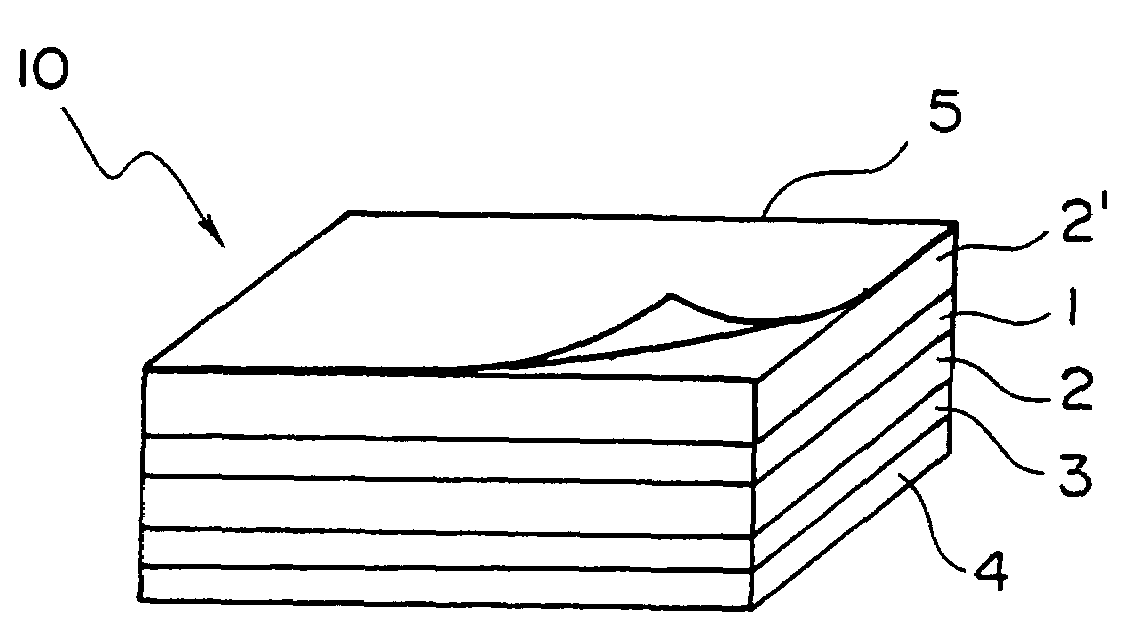Adhesive composition and adhesive optical component using the composition
a technology of adhesive composition and composition, applied in the direction of film/foil adhesives, polarising elements, synthetic resin layered products, etc., can solve the problems of inevitably losing the excellent balance between the physical properties of the adhesive, the material tends to be hydrolyzed, and the degradation of the tac film, etc., and achieves good effect of suppressing the difference in brightness and poor effect of brightness
- Summary
- Abstract
- Description
- Claims
- Application Information
AI Technical Summary
Benefits of technology
Problems solved by technology
Method used
Image
Examples
example 1
[0099]Into 200 parts by weight of toluene, 100 parts by weight of a copolymer of acrylic esters having a weight-average molecular weight of 1,200,000 (the unit of butyl acrylate: 97% by weight and the unit of acrylic acid: 3% by weight), 0.05 parts by weight of an adduct of trimethylolpropane and tolylene diisocyanate as the crosslinking agent and 0.5 parts by weight of 2,6-di-tert-butyl-p-cresol as the phenol derivative were added and a solution of an adhesive was prepared.
[0100]A substrate of a polyethylene terephthalate film having a thickness of 38 μm which was coated with a silicone resin on one face [manufactured by LINTEC Corporation; the trade name: SP PET38] was coated with the solution of an adhesive prepared above on the face coated with a silicone resin. The substrate coated with the solution of an adhesive was dried at 100° C. for 1 minute and an adhesive sheet having an adhesive layer having a thickness of 30 μm was prepared.
[0101]The prepared adhesive sheet was lamina...
examples 2 to 7
[0105]Optical components were prepared and the properties were evaluated in accordance with the same procedures as those conducted in Example 1 except that compounds shown in Table 1 were used in amounts shown in Table 1 as the phenol derivative in place of 2,6-di-tert-butyl-p-cresol. The results are shown in Table 1.
[0106]In Table 1, the phenol derivatives are abbreviated as shown in the following:[0107]C-1: butylhydroxyanisole[0108]C-2: stearyl β-(3,5-di-tert-butyl-4-hydroxyphenyl)propionate[0109]C-3: 4,4′-butylidenebis(3-methyl-6-tert-butylphenol)[0110]C-4: 3,6-dioxaoctamethylenebis[3-(3-tert-butyl-4-hydroxy-5-methylphenyl) propionate][0111]C-5: 1,1,3-tris(2-methyl-4-hydroxy-5-tert-butylphenyl)butane[0112]C-6: tetrakis[methylene-3-(3′,5′-di-tert-butyl-4′-hydroxyphenyl) propionate]methane
[0113]
TABLE 1PhenolEvaluationderivativeof propertiesamounthigh temperaturetype (part by wt.)high temperatureand high humidityExample 2C-11.5goodgoodExample 3C-22.0goodgoodExample 4C-30.5goodgoodEx...
example 8
[0114]Into 300 parts by weight of toluene, 100 parts by weight of the copolymer of acrylic esters which was used in Example 1, 50 parts by weight of a homopolymer of butyl acrylate having a weight-average molecular weight of 50,000, 0.05 parts by weight of an adduct of trimethyloloropane and tolylene diisocyanate as the crosslinking agent and 0.5 parts by weight of 2,6-di-tert-butyl-p-cresol as the phenol derivative were added and a solution of an adhesive was prepared.
[0115]Subsequently, the same procedures as those conducted in Example 1 were conducted. Under the condition of a high temperature and a high humidity, no degradation of the TAC film was confirmed and no lifting or peeling from the glass substrate was found.
PUM
| Property | Measurement | Unit |
|---|---|---|
| molecular weight distribution | aaaaa | aaaaa |
| thickness | aaaaa | aaaaa |
| thickness | aaaaa | aaaaa |
Abstract
Description
Claims
Application Information
 Login to view more
Login to view more - R&D Engineer
- R&D Manager
- IP Professional
- Industry Leading Data Capabilities
- Powerful AI technology
- Patent DNA Extraction
Browse by: Latest US Patents, China's latest patents, Technical Efficacy Thesaurus, Application Domain, Technology Topic.
© 2024 PatSnap. All rights reserved.Legal|Privacy policy|Modern Slavery Act Transparency Statement|Sitemap



